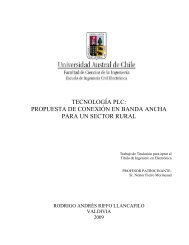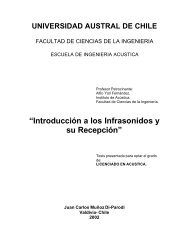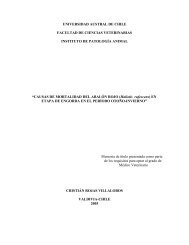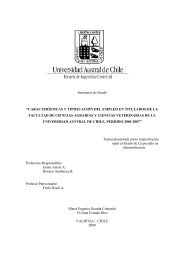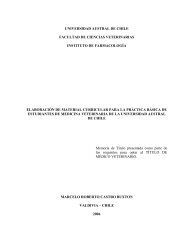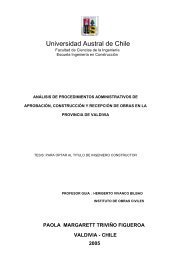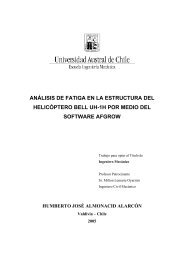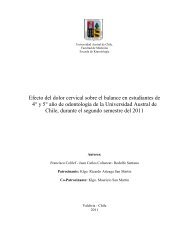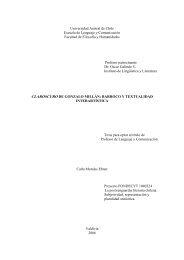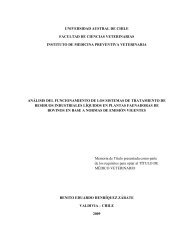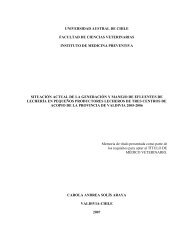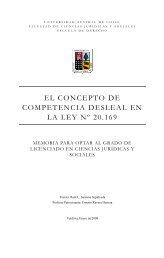Diversidad y control biológico de insectos - CyberTesis UACh ...
Diversidad y control biológico de insectos - CyberTesis UACh ...
Diversidad y control biológico de insectos - CyberTesis UACh ...
You also want an ePaper? Increase the reach of your titles
YUMPU automatically turns print PDFs into web optimized ePapers that Google loves.
Adverse effects of pestici<strong>de</strong>s on ground beetles have been wi<strong>de</strong>ly documented in the<br />
Northern Hemisphere, but little is known about the response of other populations, such as<br />
the highly en<strong>de</strong>mic Chilean carabid fauna. The level of en<strong>de</strong>mism in Chilean carabids is<br />
high (55%) and they are distinctive from the carabid fauna of the rest of South America<br />
(Roig-Juñent and Domínguez, 2001). Reducing the use of broad-spectrum insectici<strong>de</strong>s can<br />
be a particularly effective mean to conserve generalist predators (Koss et al., 2005).<br />
Conservation biological <strong>control</strong> may rarely be successful as a stand-alone tactic, but rather,<br />
needs to be combined with other pest management strategies (Koss et al., 2005). The use of<br />
entomopathogenic fungus such as Beauveria bassiana rises as a good potential alternative<br />
to <strong>de</strong>sign an IPM program for pastures consi<strong>de</strong>ring D. pallens as a primary pest and<br />
promoting actions that avoid the outbreaks of other herbivores. Some negative effects of<br />
Beauveria spp. on non-target species have been reported (Lynch and Thomas, 2000) and it<br />
is <strong>de</strong>sirable to compare the risk posed by this fungus with the risks of the insectici<strong>de</strong>s<br />
currently used against D. pallens, before to advocate scaling up its use.<br />
This study was conducted to accomplish two objectives: to compare the effects on<br />
generalist predators of both a new biopestici<strong>de</strong> based on B. bassiana and a standard<br />
chemical insectici<strong>de</strong>; and to increase the knowledge of the generalist predator assemblage<br />
in Southern Chilean pastures.<br />
Materials and methods.<br />
The study was conducted from October to December 2003 at the experimental field of the<br />
Universidad Austral <strong>de</strong> Chile, Valdivia, Chile. The naturalized pasture was comprised<br />
primarily of ryegrass (Lolium perenne L.) and Yorkshire fog (Holcus lanatus L.), with<br />
broad-leaf weeds covering less than 10% of the surface. The ca. 4 ha field was surroun<strong>de</strong>d<br />
by a road (one si<strong>de</strong>), pastures (two si<strong>de</strong>s) and a riparian area (one size). Climate is typical<br />
of temperate zones and data are shown in Figure 1.<br />
Three treatments were arranged in a completely randomized <strong>de</strong>sign, with four replicates (30<br />
x 30 m unfenced plots). One treatment correspon<strong>de</strong>d to the standard chemical insectici<strong>de</strong><br />
used against Dalaca spp., the synthetic pyrethroid lambda-cyhalothrin (7,5 active<br />
ingredient per ha, Zero, ANASAC, Santiago, Chile). The second treatment was a new<br />
biopestici<strong>de</strong> <strong>de</strong>veloped by the Instituto <strong>de</strong> Investigaciones Agropecuarias (INIA), consisting<br />
of dried spores of the fungus Beauveria bassiana co<strong>de</strong>d B-931. Based on previous studies,<br />
55



